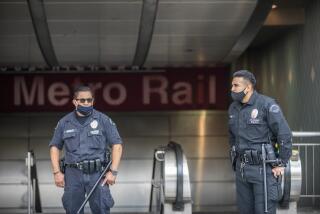Walking the Beat, Bearing Gifts
Frank Tapia, a 15-year-old high school student, was busy watching television and feeding his baby brother last week when a pair of uniformed Culver City police officers showed up unexpectedly at his doorstep and gave him the shivers.
“I was surprised,” said Tapia, who went to the door carrying the baby. “I thought something was very wrong.”
Nope, just an unusual public relations gesture.
Under prodding from the City Council, Culver City’s police chief is sending his officers door to door to visit the homes of all 40,000 of the city’s residents.
The outreach program was sparked in part by intense debate at a police community forum in November. The meeting was prompted by an article in an alternative weekly newspaper charging that the Police Department issued too many gun permits, was quick to hogtie drug suspects and routinely targeted minorities in traffic stops.
Chief Ted Cooke--a controversial figure for years because of his willingness to issue a far higher proportion of concealed-weapons permits than the Los Angeles Police Department or the Sheriff’s Department--said that rotating squads of six officers will work full time visiting homes during the next few months.
The city’s effort to put a human face on policing comes at a time when departments around the nation are seeking to soften their images and reduce the likelihood of conflicts. In New York City, where police are grappling with bitter public reaction to a fatal shooting by four officers, Mayor Rudolph W. Giuliani recently approved the distribution of cards to the force’s 40,000 police officers recommending use of terms such as Mr., Ms., sir and ma’am in addressing the public.
Said Cooke, Culver City’s police chief for 24 years: “We are out there to see if the city can do a better job. We want people to know about the positive neighborhood watch and juvenile diversion programs, which reach out to the community. We want to know how we are doing and what we can do to make things better.”
City Councilman Albert Vera, who suggested the program, said he wanted to bridge the gap between the 120-officer force and the public to “get officers more familiar with the area and get them to communicate more with people.”
Although supportive of the effort, some critics wonder if the embattled department is motivated by an auditor’s recommendation that the city reduce the agency’s size by one-fifth to save money.
“This is nothing more than a public relations campaign for the police,” said one critic, Ruth Sarnoff. “What is needed right now is a dialogue in the community dealing with why police stop so many blacks and Latino males.”
Cooke rejected the notion that his officers use racial profiles in arrests or traffic stops. “We look for suspects who commit crimes,” he said.
Culver City’s officers were bearing plastic bags with little gifts as the home-visit program began last week. They visited more than 200 homes in one night.
“We are just here to hand out some goodies,” Officer Mike Guston told one woman, handing her a bag containing a police pen, a note pad, a refrigerator magnet and several pamphlets introducing city-run programs and listing crime prevention tips.
“We are building bonds,” said Sgt. Ron Iizuka. The officers also listened to complaints--an abandoned car, a broken gate leading to Ballona Creek, speeding cars.
Mehul Desai, a father of two, said he found the visiting officers friendly. “They are saying they care,” he said.
While most residents welcomed the visits, Jennifer Mayer and her roommate had reservations when she saw the six officers walking down her street, dressed for action.
“We were a little frightened,” said Mayer. “We thought something was wrong. It’s probably a good program . . . but maybe they should send one smiling guy next time.”
More to Read
Sign up for Essential California
The most important California stories and recommendations in your inbox every morning.
You may occasionally receive promotional content from the Los Angeles Times.










